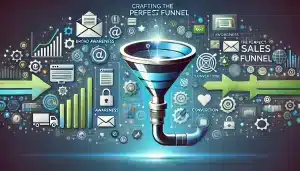Introduction
In today’s highly competitive business world, crafting an effective sales funnel is no longer optional—it’s a necessity. A well-designed Sales Funnel Drive doesn’t just guide potential customers through their buying journey; it also aligns your marketing and sales efforts to achieve maximum conversions. This article explores the concept of a sales funnel, its key stages, how to create one, and best practices to drive successful outcomes.
What is a Sales Funnel and Why is it Important?
A sales funnel is a visual representation of the customer journey from the moment they become aware of a product or service to the point where they make a purchase. A sales funnel, therefore, is important for businesses because it provides them with an analytical method of reviewing their marketing and sales efforts. Companies can tailor their strategy to meet prospects at every step in the process and drive them to conversion based on a mapped understanding of these stages.
Understanding the Stages of a Sales Funnel
The sales funnel consists of several critical stages that represent a buyer’s progression:
- Top of the Funnel (TOFU): Awareness
At this stage, businesses aim to capture a broad audience’s attention. Marketing efforts such as blog posts, social media campaigns, and SEO tactics introduce the brand and create awareness. - Middle of the Funnel (MOFU): Consideration
In this phase, prospects engage with your content and show genuine interest. This is the stage for nurturing leads by addressing their specific challenges through valuable resources like case studies, email campaigns, and webinars. - Bottom of the Funnel (BOFU): Decision
Here, the focus shifts to converting leads into paying customers. Sales teams work to eliminate barriers, answer objections, and offer incentives like discounts or free trials to encourage decision-making.
How a Sales Funnel Drives Sales
A successful sales funnel helps drive sales by providing a structured pathway for potential customers. By understanding the distinct stages, sales teams can implement targeted marketing strategies that resonate with their target audience. Moreover, using a sales funnel allows businesses to identify where prospects drop off and optimize their approach accordingly. This strategic alignment between sales and marketing enhances the entire sales pipeline, leading to improved conversion rates and higher revenue.

Key Metrics to Measure Your Sales Funnel Success
How to Build a Sales Funnel That Converts
Building an effective sales funnel requires careful planning and execution. A good sales funnel template is the foundation on which strategies can be developed to resonate with the target audience. The sales funnel must be aligned with the company‘s sales model, which allows for smooth flow from one stage to the next.
Creating a Sales Funnel Template
A sales funnel template is created with an outline of the core elements defining the sales process. The funnel must have sections for awareness, consideration, and decision-making processes. This structure will help in guiding the development of marketing strategies and sales activities specifically to the needs of the prospect at each stage. This can be further supported with landing pages and email marketing strategies.
Essential Steps to Create a Sales Funnel
Building a successful sales funnel requires several essential steps. Start by identifying your target audience and understanding their pain points. Next, attract potential customers at the top of the funnel through effective marketing strategies such as content marketing and social media outreach. Once you have generated interest, nurture these leads in the middle of the funnel with personalized communication and valuable content. Finally, focus on converting leads at the bottom of the funnel by addressing objections and providing compelling offers, such as free trials or discounts.
Avoiding Common Sales Funnel Mistakes
While building a sales funnel, avoid these common pitfalls:
- Failing to Identify Your Target Audience: Without a clear understanding of who your prospects are, your marketing efforts may fall flat.
- Neglecting Funnel Optimization: Regularly analyze your funnel’s performance and refine strategies to prevent leads from falling through the cracks.
- Overlooking Follow-Ups: Personalized follow-ups can significantly impact conversion rates, yet they’re often missed.
What Are the Stages of the Sales Funnel?
The stages of a sales funnel can be broadly categorized into three main parts: the top, middle, and bottom of the funnel. Each stage plays a vital role in the customer journey and requires distinct strategies to guide prospects toward making a decision.
Top of the Funnel: Attracting Potential Customers
The top of the funnel is where businesses focus on attracting potential customers. This stage is characterized by wide-reaching marketing efforts aimed at generating awareness. Utilizing channels such as social media, search engine optimization, and content marketing can help capture the attention of prospects. At this stage, the goal is not just to inform but to engage and encourage prospects to learn more about the product or service being offered.
Middle of the Funnel: Nurturing Leads
A lead has shown interest when she has shown that she can be interested in the final product. At this middle of the funnel, nurturance to lead is done. This can come in the form of an email marketing campaign that shares information relevant to the actual pain points of the leads. By delivering targeted content, such as case studies or webinars, companies can position themselves as thought leaders and guide prospects closer to making a decision.
Bottom of the Funnel: Converting Leads into Paying Customers
At the bottom of the funnel, the focus shifts to converting leads into paying customers. At this stage, sales reps must employ persuasive techniques to address any remaining objections and facilitate the decision-making process. Providing clear calls to action, offering free trials, or limited-time discounts can significantly enhance the likelihood of conversion. The goal is to create a seamless transition from consideration to purchase, making it as easy as possible for prospects to make a decision.
How to Optimize Your Sales Funnel for Better Results?
Optimizing your sales funnel is an ongoing process that can lead to improved results over time. By continually analyzing and refining your approach, you can enhance the effectiveness of your sales and marketing strategies.
Using Email Marketing to Manage Your Sales Funnel
Email marketing is a great tool for managing your sales funnel. With the segmentation of leads based on the stage of the funnel, businesses can communicate to meet specific needs. For example, personalized follow-up emails to prospects who have engaged with your content can be nurtured further down the funnel. Using automation tools also streamlines email campaigns and ensures timely follow-ups that keep potential customers engaged.
Effective Sales Outreach Strategies
Implementing effective sales outreach strategies is key to optimizing your sales funnel. Sales teams should focus on building relationships with prospects through personalized outreach. Utilizing social selling techniques and engaging with potential customers on platforms like LinkedIn can create opportunities for meaningful conversations. Furthermore, understanding the specific pain points of your target audience allows sales reps to tailor their messaging, making it more relevant and compelling.
Analyzing Sales Funnel Metrics for Continuous Improvement
Regular analysis of sales funnel metrics is necessary for continuous improvement. Conversion rates, lead sources, and customer feedback will help businesses identify the areas of strength and weakness in their sales process. This data-driven approach allows companies to make informed decisions about where to invest their marketing efforts and how to refine their sales strategies to get better results.
Sales Funnel Examples and Best Practices
Studying successful sales funnels across industries can offer valuable insights and inspiration.
- E-Commerce Sales Funnel: E-commerce companies often focus on product discovery and user-friendly navigation at the top of the funnel. Middle-funnel efforts include abandoned cart emails, while bottom-funnel strategies involve offering limited-time discounts.
- Service-Based Sales Funnel: For service businesses, the funnel emphasizes relationship-building. Webinars, free consultations, and educational resources help nurture trust, leading to a higher likelihood of conversion.
Successful Sales Funnel Models in Different Industries
Different industries have different sales funnel models, and they may offer valuable lessons. For example, an e-commerce company uses a simple, linear funnel, which is designed more around product discovery using attractive landing pages and intuitive navigation. A service-based industry would likely be more consultative, building relationships, providing copious amounts of information, and guiding the buyer through the process.
Case Studies: Brands That Excelled with Their Sales Funnels
Several brands have thrived by creating effective sales funnels that resonate with their target audiences. For instance, companies offering free trials attract prospects effectively because they get to experience the product or service before committing. From these case studies, strategic insights into how branding, messaging, and customer engagement can influence sales outcomes are drawn.
Free Sales Resources to Enhance Your Funnel
Take advantage of free resources to streamline and improve your funnel:
- Google Analytics: Gain insights into customer behavior and optimize strategies accordingly.
- Mailchimp: Automate email campaigns for different funnel stages.
- Canva: Create visually appealing graphics and landing pages to engage your audience.
Conclusion
A well-constructed sales funnel is the backbone of any successful marketing strategy. By understanding your audience, creating compelling content, and refining each stage of the funnel, you can drive more conversions and foster long-term customer relationships. Remember, the key to success lies in continuous optimization and alignment between your sales and marketing efforts. Ready to build your winning sales funnel? Start today and watch your business thrive!



